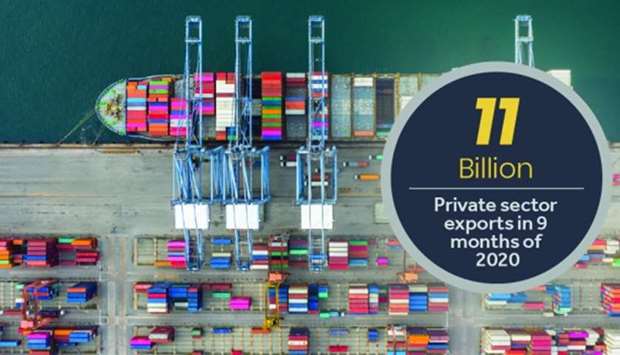Qatar’s private sector exports stood at QR11bn in the first nine months of 2020, while exports in the third quarter increased 32% to reach QR2.83bn from QR2.15bn in Q2, Qatar Chamber reported in its monthly economic newsletter for November.
The report said based on the certificate of origin issued by the chamber, private sector trade in September stood at QR1bn, reflecting a 17% month-on-month (m-o-m) increase and a 91% year-on-year (y-o-y) increase.


“[The figures] represented the lowest month in the year, showing a decrease of 44% compared to QR1.953 in February, which represented the best month of the year,” the report stated.
The report said exports through the GSP model certificate of origin had the largest value in September, increasing 128% m-o-m, followed by exports through the Unified Arab model by 18% and Unified GCC model by 4%. There were no goods exported through the Unified GCC certificate of origin for exports to Singapore, while exports through the General Model decreased by 9%.
Based on the type of commodities, there are nine main commodities representing 98% of the total volume of private sector exports in September worth QR1bn, or a 20% increase compared to QR889mn in August.
Private sector exports of helium gas and industrial gas saw a 434% jump from QR33mn in August to QR176mn in September, followed by paraffin, which increased by 96% from QR40mn in August to QR78mn, and petrochemicals exports, which saw a 96% increase from QR50mn in August over QR77mn in September.
Exports of chemical substances increased 53% from QR50mn in August to QR77mn in September, followed by lutreine, which increased 24% from QR53mn to QR65mn, and essential oils, which increased from QR258mn to QR300mn in the same period.
In September 2020, India topped the list of countries of destination for private sector exports with close to QR274mn or a 25.2% share of the total exports, followed by Oman with QR193mn and a 17.7% share, Sweden (QR120mn, 11% share), Turkey (QR116mn, 10.6%), and France (QR105mn, 9.7%).
These seven countries received 74.1% of the total value of private sector exports in September, the report stated.
Asian countries topped the list of economic blocs that received exports of the private sector with a 47% share of the total value worth QR515mn, followed by EU states with a 22% share and exports worth QR270mn.
Next on the list was the group of GCC states with exports totalling QR212mn, representing 19.4% of the total value, followed by Arab countries, excluding GCC states that received QR69mn or a 6.3% share. African countries, excluding Arab countries, registered exports worth QR20mn or an 18% share. The group’s ‘other European countries’, ‘other American countries’, and the US received exports with 0.37%, 0.06%, and 0.01% shares, respectively.
Citing figures from the Planning and Statistics Authority for September 2020, the report said the total value of foreign merchandise trade amounted to QR20.4bn, reflecting a 7.2% decrease compared to QR21.1bn in August 2020.
In September 2020, total exports (including exports of goods of domestic origin and re-exports) amounted to QR13.4bn, showing slight decrease of 4.3% compared to QR14bn in August, while imports during the same month amounted to around QR7bn, or a 1.4% drop compared to QR7.1bn in August.
Therefore, the country’s trade balance, which represents the difference between total exports and imports, showed a surplus of QR6.4bn or a decrease of 7.2% compared to QR6.9bn in August.
In September 2020, China topped the list of countries of destination for Qatar’s foreign trade with about QR3.6bn, a 17.6% share of the State’s total foreign trade, according to the report.


“[The figures] represented the lowest month in the year, showing a decrease of 44% compared to QR1.953 in February, which represented the best month of the year,” the report stated.
The report said exports through the GSP model certificate of origin had the largest value in September, increasing 128% m-o-m, followed by exports through the Unified Arab model by 18% and Unified GCC model by 4%. There were no goods exported through the Unified GCC certificate of origin for exports to Singapore, while exports through the General Model decreased by 9%.
Based on the type of commodities, there are nine main commodities representing 98% of the total volume of private sector exports in September worth QR1bn, or a 20% increase compared to QR889mn in August.
Private sector exports of helium gas and industrial gas saw a 434% jump from QR33mn in August to QR176mn in September, followed by paraffin, which increased by 96% from QR40mn in August to QR78mn, and petrochemicals exports, which saw a 96% increase from QR50mn in August over QR77mn in September.
Exports of chemical substances increased 53% from QR50mn in August to QR77mn in September, followed by lutreine, which increased 24% from QR53mn to QR65mn, and essential oils, which increased from QR258mn to QR300mn in the same period.
In September 2020, India topped the list of countries of destination for private sector exports with close to QR274mn or a 25.2% share of the total exports, followed by Oman with QR193mn and a 17.7% share, Sweden (QR120mn, 11% share), Turkey (QR116mn, 10.6%), and France (QR105mn, 9.7%).
These seven countries received 74.1% of the total value of private sector exports in September, the report stated.
Asian countries topped the list of economic blocs that received exports of the private sector with a 47% share of the total value worth QR515mn, followed by EU states with a 22% share and exports worth QR270mn.
Next on the list was the group of GCC states with exports totalling QR212mn, representing 19.4% of the total value, followed by Arab countries, excluding GCC states that received QR69mn or a 6.3% share. African countries, excluding Arab countries, registered exports worth QR20mn or an 18% share. The group’s ‘other European countries’, ‘other American countries’, and the US received exports with 0.37%, 0.06%, and 0.01% shares, respectively.
Citing figures from the Planning and Statistics Authority for September 2020, the report said the total value of foreign merchandise trade amounted to QR20.4bn, reflecting a 7.2% decrease compared to QR21.1bn in August 2020.
In September 2020, total exports (including exports of goods of domestic origin and re-exports) amounted to QR13.4bn, showing slight decrease of 4.3% compared to QR14bn in August, while imports during the same month amounted to around QR7bn, or a 1.4% drop compared to QR7.1bn in August.
Therefore, the country’s trade balance, which represents the difference between total exports and imports, showed a surplus of QR6.4bn or a decrease of 7.2% compared to QR6.9bn in August.
In September 2020, China topped the list of countries of destination for Qatar’s foreign trade with about QR3.6bn, a 17.6% share of the State’s total foreign trade, according to the report.



